- Top
- Attractions
Attractions

A trip to the sacred mountain where you can enjoy history and nature
Ikoma trip
- Since the early 7th century, Mount Ikoma has been an important gateway connecting the ancient capital of Nara with neighboring countries such as China and Goryeo (modern-day Korea).
“Kuragaritogue” or the Dark, part of modern-day National Route 308, was a major route taken by Japanese envoys to Tang China during the Nara period.
From the Nara period to the present day, it is the shortest land route connecting Namba in Osaka City and the ancient capital of Nara City.
For those interested in Japanese history and culture, Ikoma is a must-see cultural attraction.
From Jomon period settlements, to the legends of Japan's first emperor, Emperor Jimmu, and En no En no Gyoja, the founder of Chasen, to the grave of Gyoki, the monk who contributed to the construction of Todaiji Temple, to Takayama Chasen, designated as a traditional craft of Japan in recognition of its 500 years of history and techniques.
Currently, Takayama Town in Ikoma City accounts for most of the domestic production of Chasen.
Modern-day Ikoma is not only known as a university town, but is also rich in history, culture and natural beauty.
With well-developed roads and railways, and close proximity to Osaka Namba and downtown Nara, traveling from Ikoma to the city center is extremely convenient for both business and leisure.
Ikoma, with its cool summer breezes and well-preserved nature, is fresher to breathe and is an average of 2 to 3 degrees cooler than the urban areas of Osaka and Nara, making it a popular summer vacation destination since the Edo period.
nature and history together
【Hozan-ji Temple】
 【Hozan-ji Temple】It is said that En no En no Gyoja founded this ascetic training hall in the first year of the reign of Empress Saimei (655), and that Kukai (Kobo Daishi) also trained here.
【Hozan-ji Temple】It is said that En no En no Gyoja founded this ascetic training hall in the first year of the reign of Empress Saimei (655), and that Kukai (Kobo Daishi) also trained here.
It was restored by the monk Tankai in 1678, when it was called Toshidasan. "Daishomudoji Temple”
A temporary main hall was built, and later Daishokankiten was enshrined as the guardian deity.
In 1688, the new main hall was completed and the temple complex was renovated.
The temple's name was changed to Hosanji Temple.
Kankiten is popularly known as Ikoma Shoten.
As a god of business prosperity and a mysterious god who fulfills the wishes of this world,
Together with the principal image of Acala, it is popularly known as Ikoma Shoten and is widely worshipped.
Hozan-ji Temple is one of the few temples in Japan that is open 24 hours a day throughout the year.
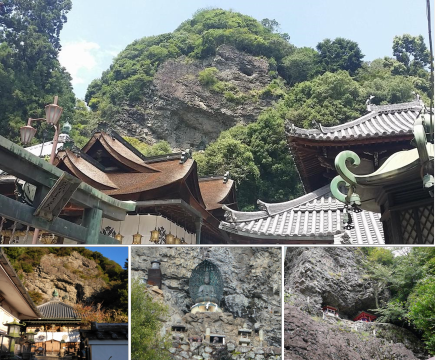 【Prajna Cave】A cave in the steep rock face behind the main hall.
【Prajna Cave】A cave in the steep rock face behind the main hall.
It is located on Asahidake.
It is said that En no En no Gyoja copied the Sanskrit Prajnaparamita Sutra and donated it here.
Maitreya Bodhisattva and Benzaiten are enshrined here.
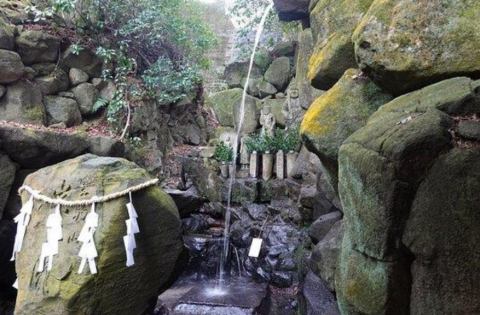 【Iwatani Falls】Mt. Ikoma was a power spot for Shugendo and Yamabushi over a thousand years ago.
【Iwatani Falls】Mt. Ikoma was a power spot for Shugendo and Yamabushi over a thousand years ago.
The enchanting waterfall, which is in harmony with nature, was once a training ground for mountain priests.
One of them is Iwaya Falls, where the mausoleum of Fudo Myoo is located.
It is also possible to walk there, but it takes about 15 minutes via a side street from Hozan-ji Temple.
Nowadays, ascetics come from not only Japan but from all over the world.
■Hozan-ji Temple Annual Events
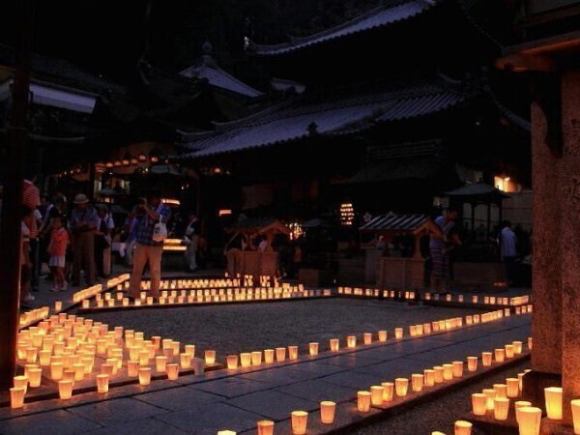 Ikoma Shoten Ohigan Manto-e is an annual Ohigan ritual held on the autumn equinox at Hozan-ji Temple, located halfway up Mount Ikoma.
Ikoma Shoten Ohigan Manto-e is an annual Ohigan ritual held on the autumn equinox at Hozan-ji Temple, located halfway up Mount Ikoma.
From the approach to the temple grounds to the temple grounds, approximately 1,000 lanterns and 10,000 candles envelop Hozan-ji Temple in a fantastical atmosphere.We then offer gratitude for the four blessings of heaven and earth, our country, our teachers, and our parents, and pray for the repose of our ancestors and the safety of our families.
This festival is also popular with photographers, and the long approach to the shrine is lined with stalls selling miscellaneous goods and food, live music, and contemporary art exhibitions.- December 16th"Dedication of the Sacred Rope to the Great Torii of Hozan-ji Temple”
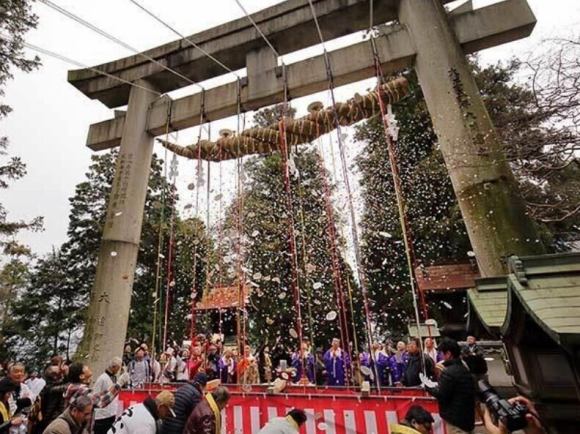 Hozan-ji Temple enshrines Kankiten as the guardian deity.
Hozan-ji Temple enshrines Kankiten as the guardian deity.
Every year on December 16th, there is an annual event called "Rehanging the Large Shimenawa."
【Ikomaniimasu-Ikomatsuhiko Shrine】
【Ikoma Shrine】
Ikoma Shrine has a very long history, and although the exact date of its founding is unclear, it is one of Japan's oldest shrines, having been enshrined here as the guardian deity of the 17 districts of Ikomaya, and, like Okami Shrine and Isonokami Shrine in Nara Prefecture, it enshrines Kannabi (Mount Ikoma) as its sacred object.
Additionally, the sacred forest that surrounds the shrine grounds has been designated a natural monument by Nara Prefecture, protecting and passing on the natural forest that has remained unchanged since ancient times.
The oldest record of the shrine is in the "Sokoku Fudoki," from the third year of Emperor Yuryaku (458), and if this is the year the shrine was enshrined, then 2009 marked its 1,550th anniversary.
Furthermore, records of this custom appear in the Shosoin documents, and the custom shows that it had connections with the Imperial Court since the Nara period.
■Ikoma Shrine Annual Events
 Held every year on the day before the sports day (second Monday in October),
Held every year on the day before the sports day (second Monday in October),
The biggest event of the year, the Fire Festival, is held at Ikoma Shrine, which enshrines the god of fire.
This is a sporting event that helps young people maintain their health and foster friendships.
Participants will be divided into north and south groups.
The players light torches from the sacred fire and run down the stairs carrying the torches on their shoulders.
The first person to reach the bottom of the stairs is the winner.- August 15"Ikoma Shrine Thousand Lanterns Festival”
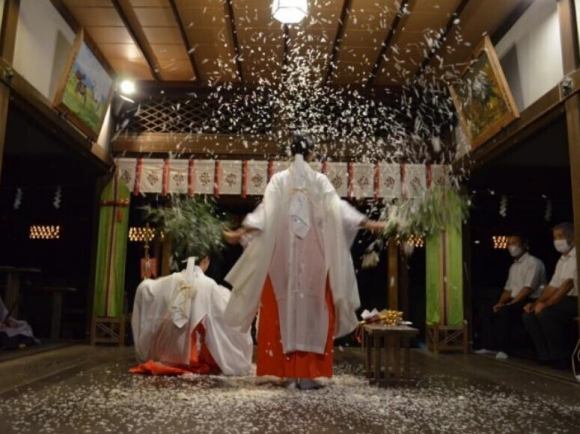 On August 15th, the Thousand Lantern Festival is held at Ikoma Shrine to pray for a bountiful harvest for the year.
On August 15th, the Thousand Lantern Festival is held at Ikoma Shrine to pray for a bountiful harvest for the year. 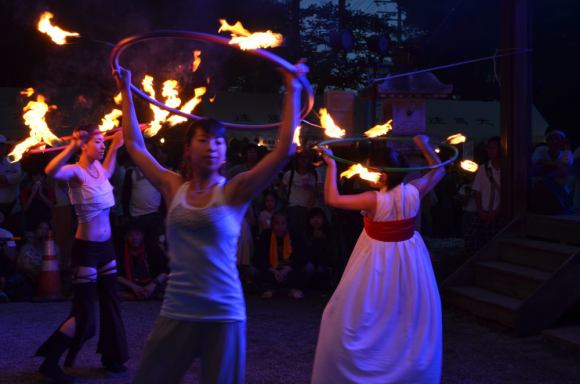 Every year, the Galaxy Festival is held at Ikoma Shrine on the first Saturday of summer vacation in July.
Every year, the Galaxy Festival is held at Ikoma Shrine on the first Saturday of summer vacation in July.
On the day of the event, the stage will be livened up with a variety of performances including Japanese drums, dance, and music.
A flea market called "Komaichi" featuring handmade items by artists will also be held at the same time.
Enjoy summer festivals, a seasonal event that is a part of the Japanese summer season, with your family and friends!- June 30th"Ikoma Shrine Summer Purification Ceremony”
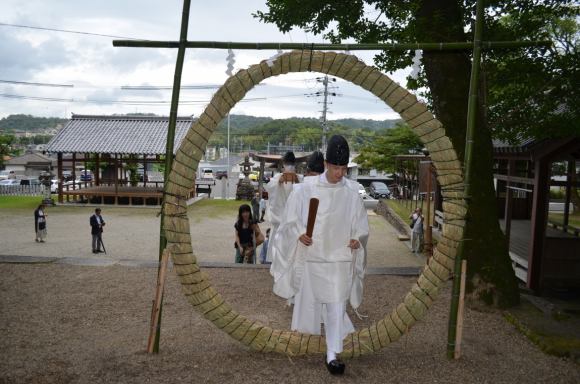 A summer tradition held on June 30th.
A summer tradition held on June 30th.
An event to pray for good health.
Crossing a ring made of straw, pilgrims write their names on paper dolls.
After blowing on it, the rice straw is washed away to pray for good health.
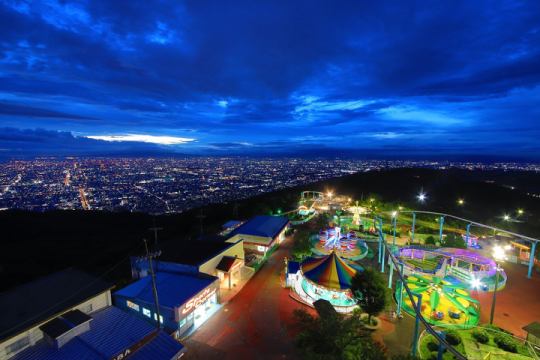
Mount Ikoma Park

